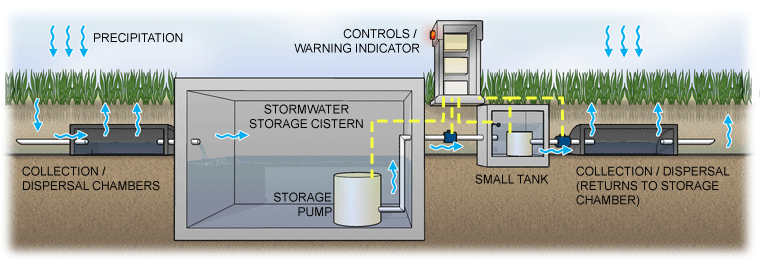
This mailer has been provided as an avenue of dispersing information related to landscape architecture in hopes of fostering greater understanding and collaboration between professions. Topics address issues that affect the built environment within which we live.
Dissecting an innovative union of stormwater and irrigation practices
"Never before in history has innovation offered promise of so much to so many in so short a time.", Bill Gates
The focus of this month's issue is an innovative water system that delicately combines the complicated biological and mechanical systems of plant physiology, soil fertility, water distribution, weed suppression and stormwater quality into a relatively simple and efficient water conservation program, more appropriately described as an artificial on-site water cycle. This system not only harvests rain water but will use it to irrigate an entire landscape without daylighting a single drop of water!
Stormwater Capture and Transport - Site specific water cycles originate with natural precipitation. As stormwater (or other sources of gray water) from landscape areas, roof run-off, and paved areas flows across the site, it is funneled into trenches filled with an engineered sand mix. As the water percolates into the sand (typically 12"-14") it is filtered and cleansed. The bottom of these trenches and the entire collection system is lined with a waterproof membrane which re-directs stormwater into underground collection chambers. As this process occurs, an artificial water table is created. As the water level rises and reaches the collection chamber connector pipes, the stormwater then spills into the next string of chambers, eventually equalizing water table heights throughout the entire system (When used as an irrigation method the entire landscape is lined with a rubber liner). When the chambers reach maximum capacity, extra stormwater is discharged into a large storage cistern where it is stored for future landscape irrigation. The size of this storage chamber will vary greatly due to project budgets, available space, and amounts of run-off. Stormwater is pumped from this chamber into a smaller tank as necessary. When instructed to do so, a pump in this smaller tank is activated and very low flows are introduced into the highest of the same collection chambers that originally harvested the stormwater. Water flows by gravity through the system of collection chambers, slowly raising water levels back to acceptable levels for plant root access.
Typical Landscape Water Cycle

Engineered Sand Fill - In order for this system to work properly in landscape applications, an appropriate planting medium is necessary. In most cases 12"-14" of sand will suffice as the planting medium. Traditionally, sand is not a sound choice for plant growth media because of limited cation holding capacity; however, when teamed with this stormwater chamber system, the impermeable lining below the sand negates the need for sand particles to hold water and nutrients. The soil solution is always suspended and readily available. Capillary action then takes over and essentially siphons the soil solution up the sand profile into root growth zones. Properties of sand including surface area, particle size and void space, create capillary action which can draw soil solutions approximately 14" up into the soil profile. For this reason sand can be used successfully as a planting medium rather than a traditional loam soil.
Nutrient Loads - As most sand mixes will generally have a modest capacity to hold natural nutrients, a carefully managed and monitored fertilizer program should focus on subsurface water and vegetation samples. This does not infer that fertilizers should be applied more often. The opposite is actually more appropriate. The stormwater system is a closed recirculating system and will recirculate nutrients through the system until used. Monitoring should be in place to avoid over fertilizing the landscape resulting in issues with salt build-up.
Automated System Control - As artificial water cycle processes are not physically visible from the surface, it is imperative that the system be equipped with automated controls and fail safes to avoid inconveniences and errors common with manually run systems. At a minimum, every project should automatically fill the small tank, distribute water through the chambers, operate based on a clock with a programmable schedule, monitor flows and halt systems in the event of pump or system failures.
Though the artificial water cycle concept is simple, the system must be designed correctly in order to function properly. There are many additional features that can be designed and implemented to fit specific projects, landscapes and site conditions. If you would like to learn more about these systems, please contact O'Dell Engineering's landscape architect for additional information.
Prior Issues of Interest
Dog Park Basics?
Playground Safety: What's the Big Deal?
Artificial Turf: A Pros & Cons Review
The Vestibular and Proprioceptive Sensory Systems
The next time you need a Landscape Architect on your project, consider O'Dell Engineering's Landscape Architecture Department.
Services include:
- Park and Playground Design
- Recreational Facility Design
- Site Planning
- Streetscape Design
- Urban Design
- Commercial Design
- Model / Production Homes
- 3-D Visualizations
- Graphic Design
- Arboriculture Consulting
- Playground Inspection
![]()
Author: Chad Kennedy, Landscape Architect
This informational article provided by O'Dell Engineering - 1165 Scenic Drive, Suite A, Modesto CA 95350
